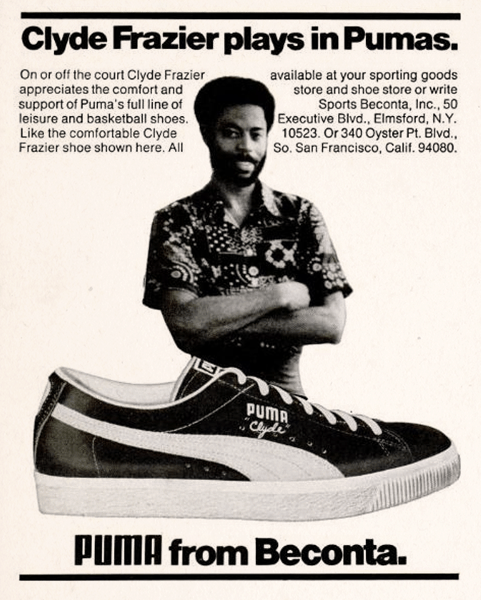Basketball legend Walt Frazier celebrated a birthday this week. He is featured prominently in the Eckhartz Press book Signature Shoes by Ryan Trembath. In honor of Frazier’s birthday, we’re posting a free excerpt about him and his famous signature shoe.

Walt “Clyde” Frazier made his professional debut in 1967 after he was drafted 5th overall by the New York Knicks of the NBA at the age of 22. Frazier had a very distinct sense of fashion, which included a penchant for wearing a mink coat and a wide brim hat like Warren Beatty’s Clyde Barrow.[1] It is rumored that Knicks teammate Dick Barnett taught Frazier how to dress (Monroe & Troupe, 2013). Some accounts have Frazier acquiring the nickname Clyde because of his prowess for stealing the basketball, but I haven’t necessarily found that to be true, and frankly, I like the hat story better. By 1973, Frazier had two NBA titles to his name and a signature shoe to go along with them – the Puma Clyde. It has been disputed that it was Frazier and not Jabbar, who was the first NBA player with a shoe contract, which, according to the book “Hard Labor,” he supposedly signed with Puma in 1971, and became the first player with a sneaker contract and shoe – the Clydes (Smith S. , 2017). Puma’s own website claims that the Clyde didn’t come out until 1973 (Puma, 2019), but Frazier’s account states otherwise: “Puma came to me, and I think my first deal was $5,000 – all the shoes I could wear. And then right after that, we won the championship, so they came out with the suede versions.” According to Barbara Smits’ “Sneaker Wars,” Frazier signed for the exact same deal that Namath had. However, Frazier made a lot more money than Namath because his shoe became a cultural phenomenon. Smit estimates that over one million pairs of the Clyde were sold in the ’70s alone (Smit, 2008). This claim is supported in the book “Slam Kicks” which reaffirms that the Clyde didn’t appear until 1973. “Slam Kicks” states that “The Puma Clyde was the first sneaker also designed to make a fashion statement. Previously, canvas was the basketball-shoe mainstay material, and in 1973 leather was just becoming popular, and suede was simply not worn” (Osborne, 2013). The claim that suede wasn’t worn at the time supports the theory that the Clyde didn’t come out until 1973 and the Puma Suede which of course was made of suede was not very successful when it came out in 1968. It wasn’t until later when the B-boys would take the Suede and Clyde to the next level.
There are various accounts on when the Clyde made its debut. It’s more than possible that the Clyde was manufactured for Frazier in 1971 but didn’t become available to the public until 1973. Grainy game footage exists from late in the 1971-72 season which features Frazier wearing the Pumas, but none from the 70-71 season. The most likely scenario involves Frazier wearing Suedes or the Puma Basket in 71-72 with the Clyde making its debut after the ’73 Championship. Whenever it was that the shoe made its first public appearance for consumption, Frazier likely asked Puma for a custom-made pair of Suedes that featured his name. However, Frazier claims the Clyde was actually modeled after the Puma Basket, which also appeared alongside the Suede in 1968. The Basket is extremely similar to the Suede, although more durable, making it slightly heavier and less flexible (Unorthodox Styles, 2005). Many people surmise that Frazier was the first NBA player with a shoe contract, but George Mikan and Bob Cousy, as well as Jabbar, would have most likely preceded him.
Frazier discussed his Puma collection in 1974, saying, “I have all different color combinations of Puma Clydes. I have pairs for practice and pairs for games. I guess during the season I use about 20 pairs. Whenever I feel I’m not getting good traction, or they feel loose, you know, I change.” (Frazier & Berkow, 1974). The Clyde doesn’t stray very far from the design of the Puma Suede, save for no Puma logo on the heel and a thinner, somewhat wider sole. According to (Unorthodox Styles, 2005), “A basic design with clean styling was counterbalanced by a whole series of colors… finding the most original colorway and matching the laces became a popular pastime, and making the shoes look wide with fat laces was a must.” Frazier, however, didn’t find it necessary to mix and match laces, saying, “When I wore a different style sneaker, I used to wear Knicks-color strings, orange on one shoe and blue on the other. Something different than conventional white. I don’t usually wear strings like that on my Pumas. The sneakers are colorful already. But I see some kids with different-color shoestrings on Pumas. They look good” (Frazier & Berkow, 1974). Frazier, like most players, wore Converse before he switched to Puma.
In the early 70’s the Clyde became one of the principal shoes for B-boys, as they are more commonly known, because they were dancing to the breaks[2] in disco music. DJ Kool Herc is by and large considered the father of hip-hop, because he was the first to take the breaks and blend it with the break in another similar sounding song. The technique was taken to another level in 1973 when Herc started using two turntables to switch between multiple breaks, extending them into a longer piece to keep people dancing, basically making an entirely new song (Serrano, 2015). Perhaps the most famous break, at least early in hop-hop, is from Chic’s song “Good Times” which would spawn “Rapper’s Delight”[3] by the Sugarhill Gang, both of which came out in 1979.
By 1970, Frazier had his first title with the Knicks, at the expense of the Los Angeles Lakers,[4] a team that included Jerry West, Wilt Chamberlain, and Elgin Baylor. At the time, the Clyde persona was already becoming a symbol of fashion in New York (Smith S. , 2017). Frazier didn’t mess around either, spending almost half of his first year’s salary with the Knicks on clothes alone. Having grown up poor, Frazier expressed a desire to dress well, and he once told GQ magazine, “I would go out, buy clothes, go to my room, dress up, and look in the mirror and say, well I ain’t playing good but I still look good!” (Sims, 2016).
After spending the first ten years of his career with the Knicks, in 1977, Frazier was traded to the lowly Cleveland Cavaliers, where he would only appear in 66 games over the course of the next three seasons. As his career was winding down, Spalding released the Spalding Clyde in 1979. They were virtually identical to his Puma signature shoe, save for the wing logo and the tagline “Wings for your Feet” (Garcia, 2013). The seven-time all-star and two-time NBA Champion was inducted into the Hall of Fame in 1987 and honored in 1996 as part of the NBA’s 50th Anniversary All-Time Team. Frazier currently serves as a broadcaster for the MSG Network, home of the Knicks, where he has been known to entertain viewers with tales of his iconic fashion sense.
[1] “Bonnie and Clyde” – 1967
[2] Short instrumental music interludes, usually drum and bass heavy. The “B” in B-Boy stands for breaks
[3] Considered the first rap song heard by ears around the world, it would peak at #36 in the U.S. on the Billboard Hot 100. Debbie Harry and Blondie get a lot of credit for their 1981 song “Rapture,” which is the first song with rap elements to make it to #1 on the Billboard Hot 100.
[4] The Knicks would again best the Lakers in ’73, but Baylor had retired in 1971.

Leave a Comment